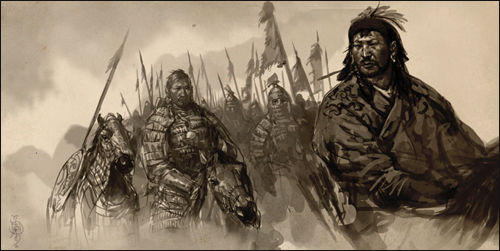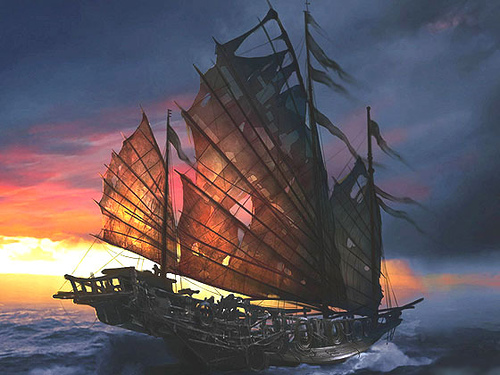Most people are under the impression that Science-Fiction and Fantasy are very easy to tell apart. One has space ships and lasers and the other has swords and magic. But when you look a bit deeper, neither genre is actually described acurately that well. There is plenty of sci-fi, like for example Ghost in the Shell or The Matrix, which have neither starships nor lasers; just as there is fantasy with barely any swords, like Buffy the Vampire Slayer, or with very little magic, like A Song of Ice and Fire. And then you have something like Star Wars
The difference between sci-fi and fantasy is instead one of themes and narratives. Sci-fi is a genre that deals with technological progress and how it might affect our life in the future. Fantasy on the other hand deals with worlds that always have been fundamentally different and usually explore how our past could have turned out differently if some basics facts of life had been different; most commonly the addition of magic and monsters. And if we go with this definition for sci-fi and fantasy for now, it’s easy to see why Star Wars quite firmly falls into fantasy and isn’t really sci-fi at all. In this universe, the technologies of space ships and lasers have been around for thousands of years and different species from different planets living side by side just as long. There is neither technological progress nor social change, everything stays as it always has been. The story itself is the classic fantasy plot of the Hero’s Journey, about fighting a dark lord and his evil legions with magic and courage. Technology is not used as new tools to deal with old problems.
Now the Mass Effect series would seem quite different on first glance. It’s not set long ago in a galaxy far, far away, but is about humans from Earth just a little more than a century in the future, who just discovered advanced technology and met other intelligent species for the first time within living memory. And the writers went to great length of effort to include the most recent discoveries of physics and technology as part of the explanation how stuff in this world works. That all looks a lot lik science-fiction. But once you start looking a bit deeper and look at the themes and plot elements, it really turns to be a pure fantasy story at heart for which the technological elements are really almost entirely decorative. Very much like Star Wars, which isn’t a coincidence. A few years before developing the first Mass Effect games, the developer BioWare had made a huge commercial and critical success with the Dungeons & Dragons based series Baldur’s Gate and continues their amazing rise to probably the most important roleplaying game developers in the West with the Star Wars game Knights of the Old Republic. However, at that point they stepped away from doing licensed games and created their own series with their own setting. Dragon Age as a successor to Baldur’s Gate and Mass Effect for KotOR. Particularly the first game resembled KotOR greatly in style, presentation, gameplay, and controls. But, as I know want to show, it also is really a fantasy story at heart as well. Obviously total spoilers for all three Mass Effect games below:
- The games have six character classes. Three pure and three hybrid. The Soldier, Engineer, and Adept are really the same thing as Warrior, Rogue, and Mage.
- The main villains are the Reapers, who are immortal beings from outside the galaxy of incredible power whose sole purpose is to kill all living people in the galaxy. A classic demon invasion plot.
- Their main soldiers are the husks, which are made from the bodies of their victims, and are basically zombies.
- The plot of the first game revolves around a powerful madman with strong magic powers collecting ancient artifacts, which he then uses in an attempt to open a portal to the distant realm of the reapers and allow them to invade invade the galaxy. An evil sorcerer opening a gate to hell to summon an army of demons is an old fantasy classic.
- On the search for the artifacts, you encounter an ancient immortal creature that has been living in the deepest chambers below the ruins for tens of thousands of years and is telepatically controlling the villagers of a nearby settlement and sends them to stop you.
- Later, in a different ruin on a different planet, you encounter an old artifical intelligence, which is basically the guardian spirit of the place, which tells you how to use the artifacts to stop the evil sorcerer from summoning the demonic army.
- Right at the start of the second game, the hero is killed, but two years later brought back to life with magic! I mean with SCIENCE!!!
- At the end of the game, the hero and the team of companions have to travel through an ancient and mysterious portal to find the lair of their enemy. To do that, theh first have to find a special key that allows them passage through the portal without being destroyed like the hundreds who tried to pass through it before them.
- They find that special key in the very heart of the gargantuan corpse of one of the ancient demons. Where of course it’s spirit is still present and turned the earlier explorers into zombies.
- When they finally make it through the portal to the villains lair, it all looks as if they have travelled right into hell. And inside the lair they find a gargantuan monster that is being build from the bodies of thousands of humans.
- In the third game, all the Free People have unite to find an ancient artifact that may be the only way to stop the demons. And of course to do so the hero has to assault the main base of the demons and confront the god that controls it all.
- At one point, you need to get the Krogans on your side, butt they agree to help only under the condition that you cure a terrible disease that has been spread over their world as punishment for their endless invasions and conquests of other planets. Basically, they want you to life an ancient curse laid on their ancestors.
- To do so, you have to access a science station on their planet where one of your allies will produce a cure and use the station to spread it over the entire planet. Said cure can only be made from the blood of a single Krogan woman, who also happens to coincidentally be one of the very few high priestesses of the ancient religion.
- However, you can’t reach the station, as it is build behind an old abandoned temple, which is currently inhabited by one of the immortal demons. So what you do is to start the ancient machines that the Krogans used to summon the great titanic creature they revered as a destroyer and mother of the most terrible monsters on the planet. You really perform an ancient ritual to summon one of the old pagan gods, who arrives to destroy the demon!
- On another planet, you discover that the most advanced species with the best technology and magic powers have actually been altered by an even more powerful but now extinct race of creatures. They also have another one of the artifical intelligences hidden inside their great cathedral, who is like a messenger from their old gods, who has been teching them all the secrets of their technology.
- In addition to the demon army that wants to destroy the world and take everyone back to their realm, there is also another antagonist who believes he has the power to make the demons his slaves and through them become the ruler of the galaxy.
It may be a sci-fi setting, but the main story and many of the side stories really are fantasy stories through and through.


